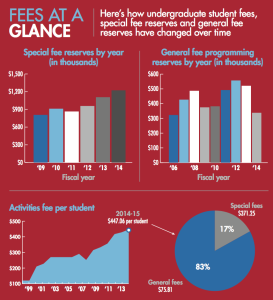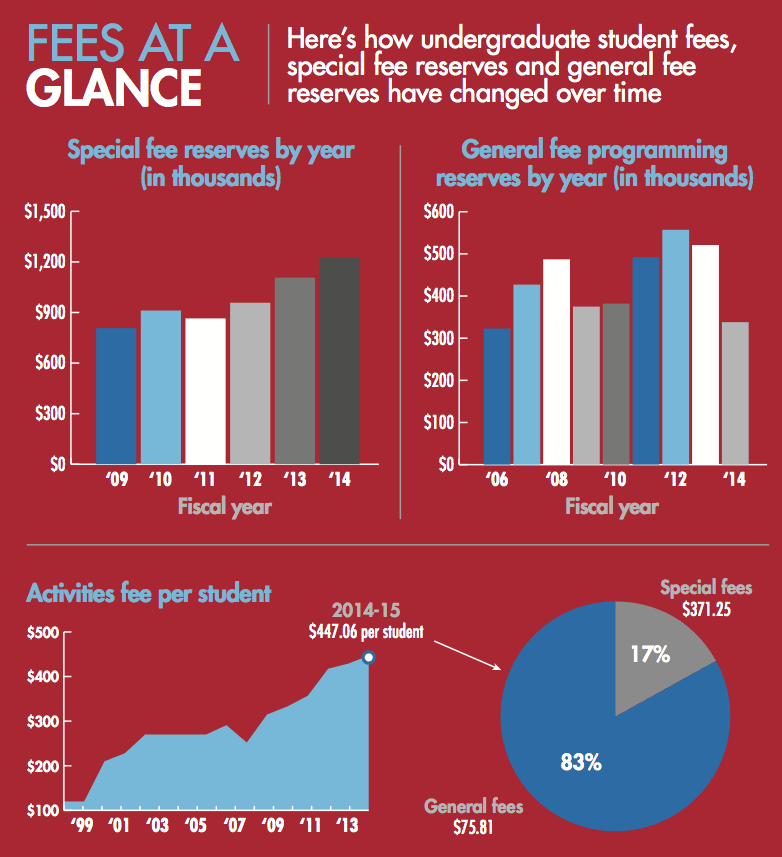
After a quarter of struggling to fund student groups (or voluntary student organizations, VSOs), the Undergraduate Senate has called a special election to be held Thursday and Friday for a vote on funding reform.
This is not the first time funding reform has been on the ballot.
The major item on last year’s Spring Election ballot was SAFE Reform, which did not receive the votes necessary for passage.
While the issues with funding began prior to this quarter, they have become notably acute over the past ten weeks, prompting the Senate to call the special election, despite concerns about a lack of time for discussion among the student body.
“Just this quarter, student groups requested $450,000 out of a fund that only has $350,000 for the year. And that indicates that there just isn’t enough money there,” said Senate Chair Ben Holston ’15.
“We had to deny groups [funding for] their baseline operation which they’ve been approved by the University to do,” Senator John-Lancaster Finley ’16 said. “And that’s not something that the funding system is supposed to do.”
Financial system overview
While there are sufficient funds in the overall ASSU financial system, the ability to efficiently allocate those resources remains difficult.
The ASSU’s funding system is complicated, with two main avenues through which a student group can currently receive funding: special fees and general fees.
Of the 600-plus registered student groups, most fall into the general fees category, meaning they can receive up to $6,000 in funding per year directly from the ASSU. That money is disbursed weekly by the Senate.
Around 65 groups each year request special fees, which are voted on by the student body in the spring election. There is no hard cap on how much funding these groups can receive. Additionally, special fees groups are allowed to maintain reserves if they do not spend all the money the student body has allocated to them.
The general fees fund only has a budget of $350,000 per year. Currently, there is a total of about $1.2 million in the reserves of special fees groups.
“What this reform is about is about getting [general fees] groups more money,” Holston said. “There are a lot of other issues in the system but at a very basic level that’s [what’s going on].”
SAFE Reform legacy
The new proposal is not simply a repackaged SAFE Reform. While the disbursement system for funds is similar, according to Finley, who authored the proposal on the ballot, the controversial parts of SAFE Reform are gone, including the creation of an independent funding board and a cap on the student activities fee.
After the failure of SAFE reform, the Senate was eager to get as much student input as possible on the new funding reform bill.
The Senate held a number of town hall-style meetings throughout the fall to gather feedback from students, particularly student groups.
Finley said that the decision to remove the funding board was largely driven by the meetings in which student groups unanimously expressed disapproval of the idea. In the same meetings, most students weren’t largely concerned with the high student activities fee itself, and didn’t think that special fees reserves should be completely eliminated. Both of these sentiments are reflected in the changes the bill proposes.
Some, however, remain skeptical that the focus on student input was useful.
Ilya Mouzykantskii ’16, who was an ASSU Senator last year, said that the complexity of the ASSU funding system and how difficult it is to understand prevented many students from giving feedback on the bill.
“Senate did everything they could to solicit student input, but frankly, when no one understands what is going on, including Senators, there’s only so much student input you can solicit,” Mouzykantskii said.
Breakdown of the bill
If passed, the funding reform bill will overhaul the current system of special fees and general fees, replacing those categories of student groups with a system of grants: annual, standard and quick grants.
Annual grants will be voted on during the spring election. Standard grants will be disbursed by the Senate at the beginning of every month. Quick grants can be given at any time.
For special fees groups that are operating on a large budget, the process of applying for funds will be almost identical to the process under the current system. Groups will submit a budget request to the Senate which, if it approves the budget request, place the request on the ballot in the spring election. These annual grants will function similarly to special fees.
The main difference, however, between annual grants and special fees is how the Senate intends for student groups to budget. According to the official proposal, annual grants will only be given for “expenses that can be accurately predicted.”
Standard grants would essentially serve in place of general fees. In the new system, a student group would submit a budget and, if approved, would be awarded money by the Senate at the first Senate meeting of every month.
This gives student groups more flexibility in planning. Instead of having to guess at the cost of a new event for the following year nine months in advance, a group can wait until closer to the event when it has a better sense of how much money it will need. As a result, the money can be more efficiently used.
Quick grants are also available to student groups that need funds for unforeseen expenses. Quick grants are approved by the Senate Appropriations Committee, which can award up to $6,000.
Besides the nominal and organizational changes to the current funding system, the other major component of the reform is a taxing mechanism that allows the Senate to reclaim unspent money from student groups.
The bill explains that the tax on a group’s unspent funding will “be assessed on the total amount of funding unspent in a given fiscal year.”
The tax rate will vary from group to group and, according to the bill, will be set based on “the size of a group’s existing reserve funds, plus its amount of unspent funds, as a percentage of its budget in a fiscal year.”
The tax mechanism would only kick in if a group’s reserve holdings exceed 80 percent of its annual budget. For example, if a group’s annual budget is $100 and at the end the year the group has a reserve of at least $80, then any unspent money given by the Senate to the group in that year is subject to being taxed. Money collected from this tax system will be reallocated for Standard and Quick grants the following year.
To address student groups’ concerns about needing large reserves for special circumstances, the bill has a clause that permits VSOs to apply for exemption from taxation by submitting an application to the Senate Appropriations Committee.
The bill will not affect money currently sitting in reserve accounts but would only apply to money that goes unspent in the future.
Under this system of grants, the two pools of money set aside for general fees and special fees groups will become one pool of money that is funded by the student activities fee.
Response from student groups
Last spring, the Students of Color Coalition (SOCC) was one of the most proactive student coalitions opposed to SAFE Reform. As a result, the Senate has made a concerted effort to reach out to SOCC groups.
“The Senate did a good job this year of reaching out to different VSOs on campus,” said Ashley Harris ’15, President of the Stanford American Indian Organization, a SOCC-affiliated group. “Several Senators asked me in person what my thoughts as a student group leader were about the funding reform during the process.”
The NAACP and the Black Student Union (BSU) were among SOCC groups that interacted that were reached out to as well.
“As far as outreach, the ASSU has been diligent about keeping us informed,” said BSU co-president Shelby Sinclair ’15, “They sent student leaders multiple drafts of the funding bill and made revisions to the bill during our in-person meeting.”
However, although ASSU representatives have met with several student group leaders and have heard almost generally positive feedback to the proposal, no student group has officially endorsed the proposal.
“We haven’t heard any group come out with strong, strong opposition to anything,” said ASSU Financial Manager Frederik Groce ’14. “The only opposition we’ve heard thus far that’s been very publicly announced was actually [an editorial] from The Daily [Editorial Board] itself and it was not aimed at the actual content of the bill but at the timeline.”
For now, it seems that the focus for some SOCC organizations is not to take a public stance for or against the bill but rather to educate their members on the proposed funding reform system.
“SAIO isn’t taking an official stance for or against the funding reform at the moment because we are trying to inform members and find out what their concerns may be,” Harris said.
In order to pass, 15 percent of the student body must vote in favor of the bill and at least two thirds of the total votes must be in favor of the bill. If passed, the new funding system will go into effect at the beginning of spring quarter.
Nikhita Obeegadoo also contributed to this article.
Contact Andrew Vogeley at avogeley ‘at’ stanford.edu, Chelsey Sveinsson at svein ‘at’ stanford.edu and Katie Zingheim at zingheim ‘at’ stanford.edu
